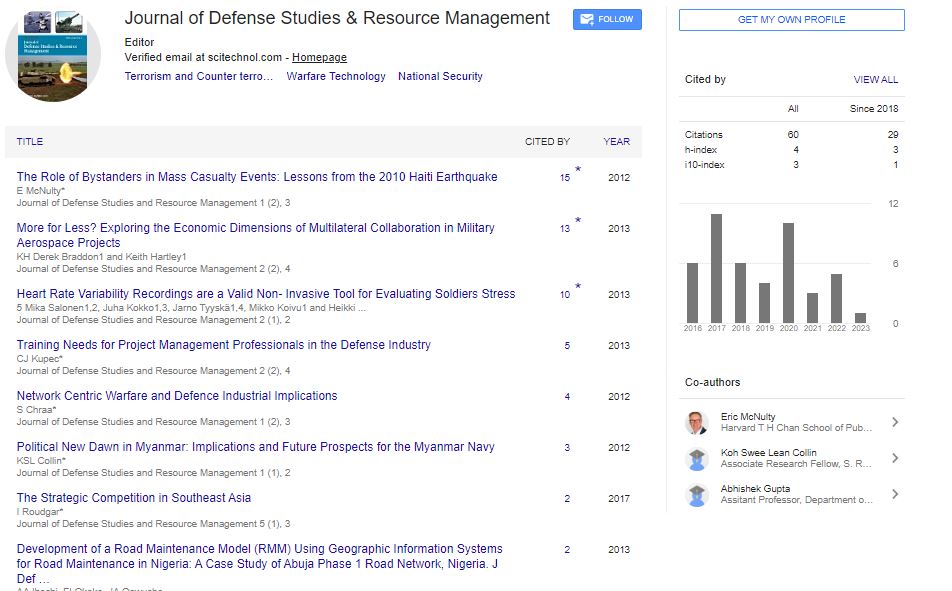Opinion Article, J Def Stud Resour Manage Vol: 11 Issue: 4
Exploring the Strategic Versatility of C-4 in Modern Military Operations
Rattin Trushlakov*
1Department of Accounting, Economics and Finance, University of the West of England, Bristol, United Kingdom
*Corresponding Author: Rattin Trushlakov,
Department of Accounting,
Economics and Finance, University of the West of England, Bristol, United
Kingdom
E-mail: trushrattin7@live.uwe.ac.uk
Received date: 30 October, 2023, Manuscript No. JDSRM-23-120620;
Editor assigned date: 01 November, 2023, PreQC No. JDSRM-23-120620 (PQ);
Reviewed date: 16 November, 2023, QC No. JDSRM-23-120620;
Revised date: 23 November, 2023, Manuscript No. JDSRM-23-120620 (R);
Published date: 30 November, 2023, DOI: 10.4172/ 2324-9315. 1000188
Citation: Trushlakov R (2023) Exploring the Strategic Versatility of C-4 in Modern Military Operations. J Def Stud Resour Manage 11:4.
Abstract
C-4, a plastic explosive renowned for its destructive capabilities and versatility, has become an iconic symbol of modern warfare. Developed in the mid-20th century, this composition has played a pivotal role in military operations, counter-terrorism efforts, and demolition applications. In this article, we will delve into the composition, properties, and applications of C-4, shedding light on its significance in the realm of explosives. C-4, short for Composition 4, is a malleable plastic explosive composed of crystalline grains of RDX (cyclotrimethylenetrinitramine), a powerful high explosive. The RDX crystals are mixed with plasticizers, such as dioctyl sebacate, and a binder material, typically polyisobutylene, to form a flexible and moldable explosive compound.
Description
C-4, a plastic explosive renowned for its destructive capabilities and versatility, has become an iconic symbol of modern warfare. Developed in the mid-20th century, this composition has played a pivotal role in military operations, counter-terrorism efforts, and demolition applications. In this article, we will delve into the composition, properties, and applications of C-4, shedding light on its significance in the realm of explosives. C-4, short for Composition 4, is a malleable plastic explosive composed of crystalline grains of RDX (cyclotrimethylenetrinitramine), a powerful high explosive. The RDX crystals are mixed with plasticizers, such as dioctyl sebacate, and a binder material, typically polyisobutylene, to form a flexible and moldable explosive compound. This composition gives C-4 its distinctive putty-like consistency, making it easy to shape and apply to various surfaces. One of the key attributes of C-4 is its stability. Unlike many conventional explosives, C-4 is highly resistant to shock, impact, and even fire. This stability makes it safe to handle and transport under controlled conditions, allowing for strategic deployment in diverse operational environments.
Applications in military operations
C-4 has been a weapon of choice for military forces worldwide due to its reliability, potency, and ease of use. C-4 is extensively used in engineering and demolition tasks, ranging from breaching obstacles to destroying infrastructure. Its mouldable nature allows for precise shaping of charges to achieve desired effects. C-4 is employed in the creation of explosive devices designed to neutralize both personnel and material targets. Its versatility allows for the construction of lethal devices suitable for various tactical scenarios. Special operations forces often utilize C-4 in covert missions, such as sabotage and destruction of enemy assets. Its stability and low volatility make it a preferred choice in these high-stakes operations. Law enforcement agencies use C-4 in counter-terrorism efforts, particularly in scenarios requiring controlled explosions to disable or neutralize explosive devices. Its precise application is crucial in minimizing collateral damage and ensuring the safety of civilians. While C-4 offers unparalleled effectiveness in military applications, its use has raised concerns about environmental impact and ethical considerations. The manufacturing, deployment, and disposal of C-4 raise challenges related to pollution and the long-term effects of explosive residues. Additionally, there are ethical considerations surrounding the use of such powerful explosives in conflict zones, particularly regarding collateral damage and civilian safety.
Conclusion
C-4 plastic explosive stands as a testament to human ingenuity in the field of military technology. Its stability, versatility, and potency have made it a cornerstone in the arsenal of military and law enforcement agencies. As we navigate the complexities of modern warfare, the responsible and ethical use of C-4 remains a critical consideration. Its impact on military operations, from demolition tasks to covert operations, underscores its significance in shaping the landscape of contemporary conflict. In contemplating the future, the continued refinement of explosive technologies demands a parallel commitment to ethical considerations, environmental stewardship, and international cooperation. As C-4 evolves, responsible innovation will be key to mitigating potential risks and ensuring a safer and more secure global landscape. As technology advances, the role and applications of C-4 will likely continue to evolve, posing new challenges and opportunities in the realm of explosives and warfare.
 Spanish
Spanish  Chinese
Chinese  Russian
Russian  German
German  French
French  Japanese
Japanese  Portuguese
Portuguese  Hindi
Hindi 